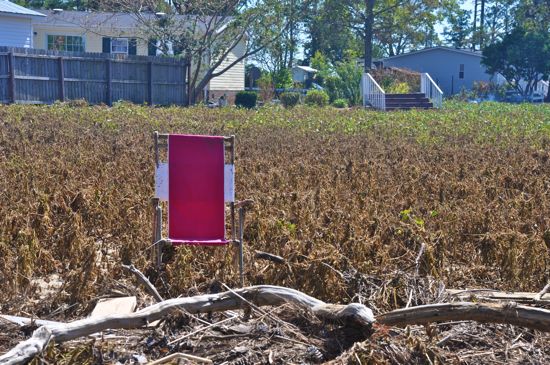It's Sunday January 18, 2026
September 16, 2011
In the few miles southwest of Oriental, several small neighborhoods stretch out, single file and line the shore of the Neuse River. The waterfront land is a draw and it delivers. From the homes and the porches and docks there, the nation’s widest river stretches out at just about its widest point.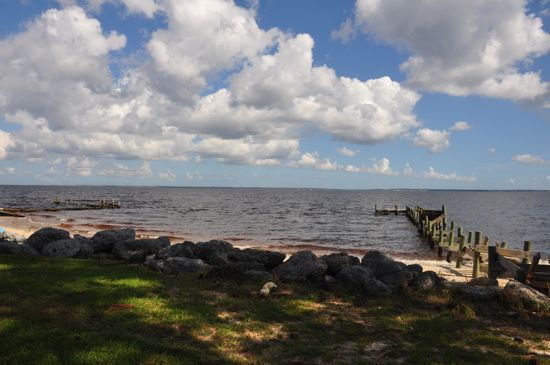 Blue skies over a few miles of the Neuse River as seen from China Grove. Eight days earlier, Hurricane Irene was lashing the docks, the beach and the homes there.
Blue skies over a few miles of the Neuse River as seen from China Grove. Eight days earlier, Hurricane Irene was lashing the docks, the beach and the homes there.Hurricane Irene showed that the same river that provides such a wide view, also brings several miles of fetch. That was made clear over and over during visits to China Grove, as well as Neuse Village Road and Hardison Lee Farm Road in Arapahoe.
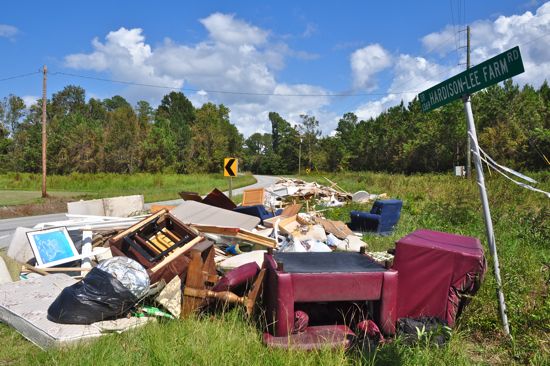 Furniture and other debris piles up along Janeiro Road in Arapahoe in the days after Hurricane Irene. All along the Neuse to the south and west of Oriental, homes were hit hard. One resident said the buildings were reduced to “breakwaters” as Irene rolled in.
Furniture and other debris piles up along Janeiro Road in Arapahoe in the days after Hurricane Irene. All along the Neuse to the south and west of Oriental, homes were hit hard. One resident said the buildings were reduced to “breakwaters” as Irene rolled in.The residents flooded there include Ross Pease, dockmaster at Oriental Harbor Marina, Jim Edwards who runs the Bow to Stern sailing classes in Oriental, novelist Liza Wieland and Jayne Stasser, a regular vendor at the Oriental Farmers’ Market. From this sampling, a glimpse in to both the force of Irene and what it’s like to live near what is usually a placid river. But sometimes isn’t.
We start in Arapahoe, just off of Hardison-Lee Road where Ross Pease lives with his wife, Donna.
“Yes, it’s wonderful to live on the water and yes, it’s great.” says Donna Pease, “but at what price? I just don’t know if sitting on that pier is worth it anymore.”
Donna Pease is surveying her yard on the Neuse River, about a mile from Dawson’s Creek. Their brick ranch house had flooded a few inches in Hurricane Isabel. But as many others found, Irene was different.
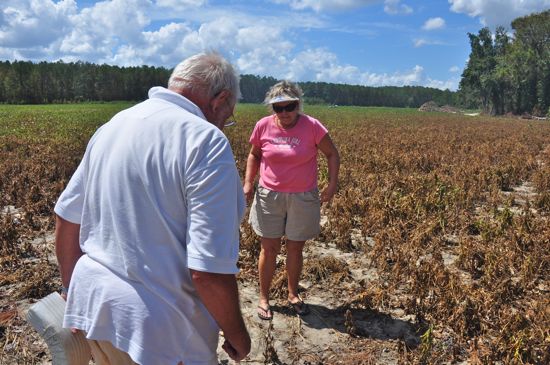 Ross and Donna Pease left their flooding home during Hurricane Irene and then waded and swam across the soybean field behind them to get away. A week later, they were still finding things amid the plants, such as the gutter pipe Ross is holding.
Ross and Donna Pease left their flooding home during Hurricane Irene and then waded and swam across the soybean field behind them to get away. A week later, they were still finding things amid the plants, such as the gutter pipe Ross is holding.“Isabel rolled in, “ she says. “This one crashed in.” Around 8 on that Saturday morning, the waves pushed through a door in their sunroom and from there in to their house, a few steps up from the porch. A propane tank floated by. The eye of the storm was still an hour away and their house was flooding.
Donna and Ross made the decision to leave with the clothes on their backs. With two friends, brothers Joe and Tom Hempel who were visiting from out of state, they set out toward a neighbor’s whose house was up on pilings. They waded across the yards but then Donna says, the strong current coming off the river kept their neighbor’s staircase out of reach.
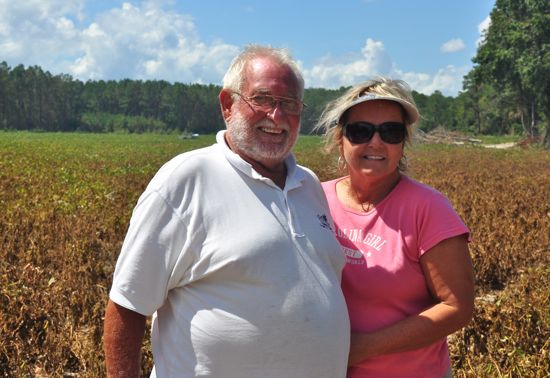 Ross and Donna Pease and the soybean field that was a sea they crossed during Hurricane Irene..
Ross and Donna Pease and the soybean field that was a sea they crossed during Hurricane Irene..A vehicle was half a mile away on Hardison Lee Farm Road, so, with the current behind them, they walked and waded down the dirt road out of their neighborhood. Soon that path was blocked by a fallen tree. One of their friends pointed to the soybean fiel whose plants he had noticed a few days earlier were only 2 or 3 feet high; now he was seeing tops of the plants at the far end of the field. The four of them swam and waded across the sea of soybeans. Ross’s dog Leo swam back twice to Ross and one of their friends who were lagging behind.
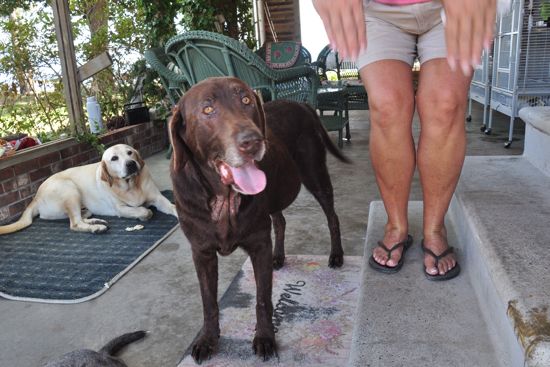 Loyal dog, Leo, swam back twice to Ross Pease. Ross’ wife, Donna, says once they got to a truck and drove to New Bern, Leo stayed wedged between them in the back seat, his head on the console and his paws (as Donna demonstrates) over the edge.
Loyal dog, Leo, swam back twice to Ross Pease. Ross’ wife, Donna, says once they got to a truck and drove to New Bern, Leo stayed wedged between them in the back seat, his head on the console and his paws (as Donna demonstrates) over the edge.Getting to the vehicle was just the beginning. The four of them — and the two dogs, Stella and Leo — navigated the roads of the county. They tried to get to Donna’s workplace — Worldwide Marine Training — where they thought they could stay, but the roads were blocked by downed lines. They traipsed back to 306 and to the courthouse in Bayboro. From there, they worked their way to a friend’s place in New Bern. It was 5:30p by then.
A week later, Donna says she realizes that they did everything they weren’t supposed to do. They stayed at their home til the height of the storm and then tried to get away. We are lucky, she says. Physically, their injuries were few. Ross shows a bit of poison ivy he brushed in to climbing out of a ditch at the end of the field.
[page]
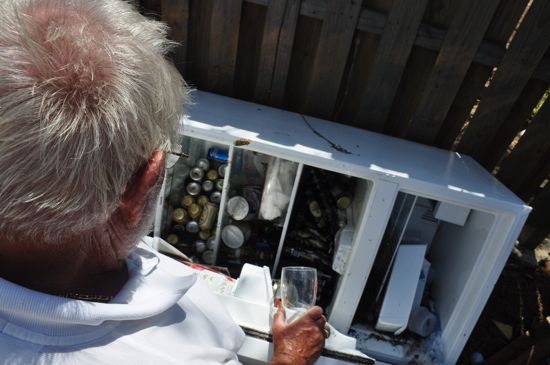 Ross Pease’s bar refrigerator — the Rosserator — floated in to a neighbor’s yard during Irene. Inside, a healthy stash of Guinness. The white on those black is not frost, but a week’s worth of mold.
Ross Pease’s bar refrigerator — the Rosserator — floated in to a neighbor’s yard during Irene. Inside, a healthy stash of Guinness. The white on those black is not frost, but a week’s worth of mold.As many others are finding, the enormity of the task ahead weighs heavily. Small things take on great significance. Donna laughs that she got the best psychological therapy that past week by spending $100 at a laundromat. She’d gone there a few days after the hurricane, with heaps of wet clothing that she wanted to keep from getting mildewed.
But when she got there, she had a moment of disconnect. Everyone else seemed to know what they were doing, she says, “But I haven’t been to a laundromat in 35 years.” She nods towards Ross. “Not since he proposed to me.” Donna says she stood still until the man running the laundromat, “came over and said, ‘Do you need some help?’”
Chair in the soybean field, amid other float-aways from Hurricane Irene. In the background a stairway that drifted away in the force of the waves.Her voice goes small and trembles as she retells it. “I said, ‘Yes. I need some help.’ “ (She says she has since returned — there is a lot of laundry to do — and handles the machines with ease.)
The only thing left to be upset about, Donna Pease says, is whatever other things she may find in the house, and she expects, her now-waterlogged wedding photos. “But you know what,” she says, “Plenty of people have lost their wedding photos.” She mentions that she’s just met a couple who didn’t even have the walls of their home standing after a flood.
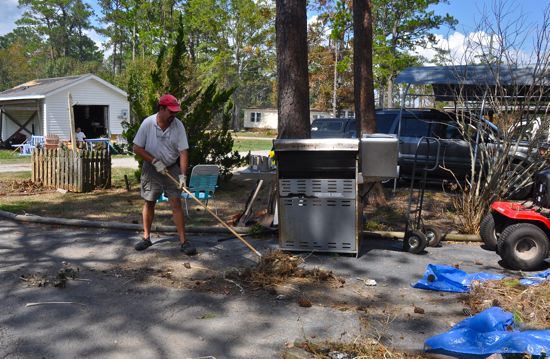 Kevin Quade flew in from St Louis and was helping the Peases with Irene clean-up a week after the hurricane.
Kevin Quade flew in from St Louis and was helping the Peases with Irene clean-up a week after the hurricane.Still, Donna Pease has reservations about being vulnerable to flood again. “My sister says I’ll feel different in three weeks,” she says. “She says, ‘Wait ‘til you get a new floor.’”
And that is what they are working toward, after first getting their house dried out and treated for mold and mildew. In the meantime, they live at a friend’s place in the neighborhood and other friends drop by to pitch in. That, Donna Pease says, gave her new insight in to lending a hand when a friend is in need. She says she’ll never tell a friend in need, “give me a call if you need something.’ because she’s found that often people grappling with losing a house — or a loved one — often don’t know what they need. Doing something, anything, to help out, will long be remembered.
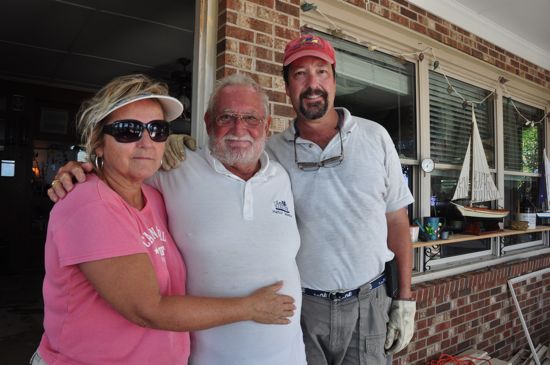 Donna and Ross Pease and Kevin Quade on the sunporch where Ross watched Irene’s surging waves crashed down a door. Kevin was among several friends who stopped by to help with the cleanup.
Donna and Ross Pease and Kevin Quade on the sunporch where Ross watched Irene’s surging waves crashed down a door. Kevin was among several friends who stopped by to help with the cleanup.[page]
Neuse Village Road is off of Janiero Road, not far from Dawson’s Creek and it ends with a row of 5 homes that were built decades ago. Each one faces the Neuse River. Originally, all were single story, ranch-style buildings, made of cinderblock.
Since then, some homeowners have built two stories on top of them. One left that original floor as a garage, others kept the first floor as living space.
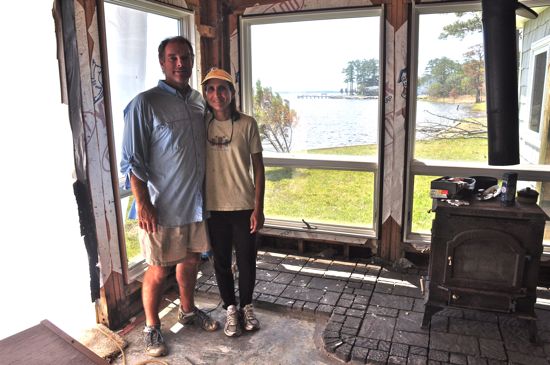 Jim Edwards and Stephanie Carperos near the windows that blew in from the force of Irene’s waves. They weren’t there for the hurricane but have been working on that floor of their home since, stripping out walls and floors.
Jim Edwards and Stephanie Carperos near the windows that blew in from the force of Irene’s waves. They weren’t there for the hurricane but have been working on that floor of their home since, stripping out walls and floors.Jim Edwards, who runs the Bow to Stern sailing classes for kids in Oriental, and his wife Stephanie Carperos weren’t living there in 2003 when Hurricane Isabel swept through and brought water in to those first floors.
They had been under the impression that Isabel had less storm surge than it actually did so that when they added two stories to their home a few years ago, they kept most of the living quarters on the bottom floor. There, four large windows faced out on to the river.
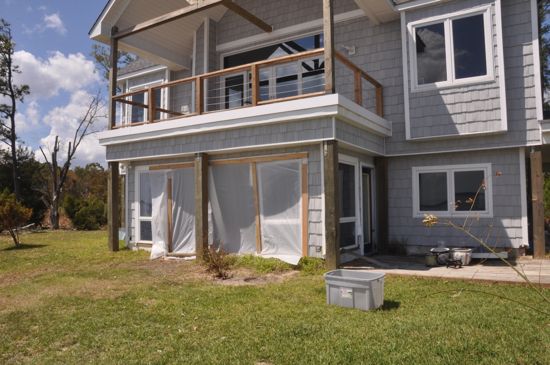 Windows blew in and the first floor of the home flooded in Irene.
Windows blew in and the first floor of the home flooded in Irene.Jim and Stephanie and their teenaged daughters were not in the home at the time — but a neighbor who was, Flora Moorman, says the row of homes there were reduced to being like breakwaters as Irene and the Neuse pounded landward.
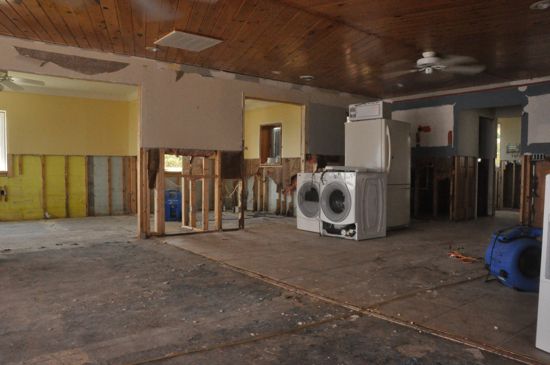 A week’s worth of work, post-Irene, at the Edwards’ home. Water-damaged sheetrock had to be removed, exposing studs in room after room, while flooring had to be taken down to the substrate. It’s a sight repeated often in Pamlico County after the hurricane.
A week’s worth of work, post-Irene, at the Edwards’ home. Water-damaged sheetrock had to be removed, exposing studs in room after room, while flooring had to be taken down to the substrate. It’s a sight repeated often in Pamlico County after the hurricane.The family came back to find the windows pushed far in to what had been their kitchen and living room. They spent the following week pulling out sheetrock and insulation, running heavy duty fans and beginning to sort out what to do next.
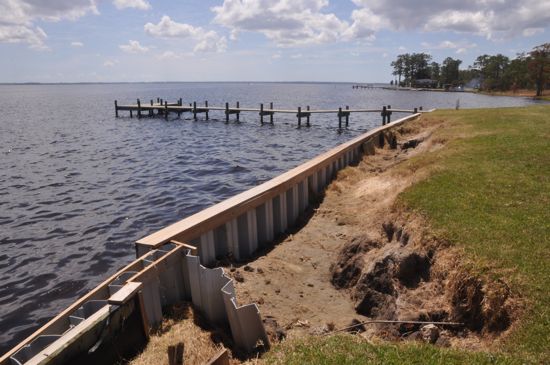 The bulkhead remained, but the ferocity of the wave action scooped out the land behind it in their yard facing the Neuse.
The bulkhead remained, but the ferocity of the wave action scooped out the land behind it in their yard facing the Neuse.[page]
Two doors down Neuse Village Road, Liza Wieland and Dan Stanford have now dealt with three hurricanes in eight years. The creative-writing professors purchased their one-story home just before Isabel in 2003. The river surged in and put 22 inches of water on the floor inside.
Liza is a short-story writer and novelist and her essay, “Upon The Flooding Of Our House” was published after Isabel. For Hurricane Ophelia two years later, there was less to write about. Dan was prepared for that one, rigging sandbags, tarps and plywood by the doors, but Ophelia’s waters didn’t get high enough to test it.
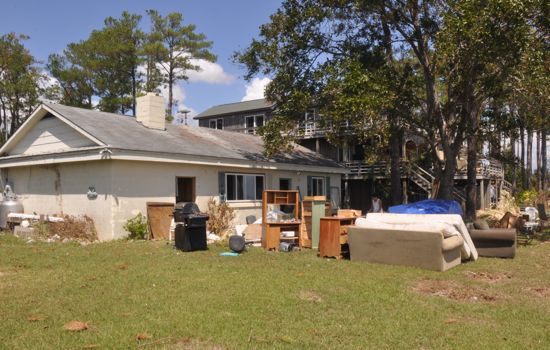 Airing out. Dan Stanford and Liza Wieland’s home on the Neuse River.
Airing out. Dan Stanford and Liza Wieland’s home on the Neuse River.Irene, though, was another story. (Indeed, she says it has provided material for a character in her next novel.) The hurricane brought water to their windowsills. Thirty-seven inches filled the house.
Liza and Dan and their daughter rode out the hurricane in Greenville, and in the week after Irene, they spent every day cleaning up and finding what could and could not be salvaged. Their daughter, an avid reader, lost a library of books. They put belongings out to air on the lawn, just steps from the same river that caused all that trouble.
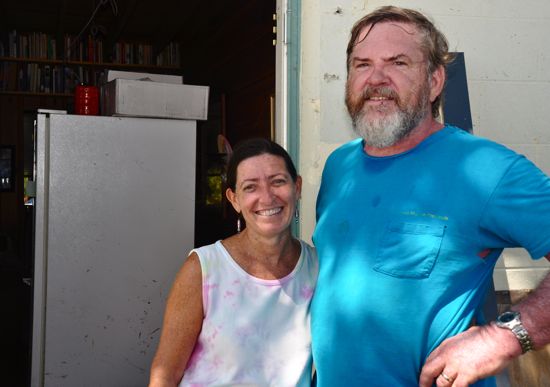 Liza Wieland and Dan Stanford.
Liza Wieland and Dan Stanford.Pausing for a moment in the clean-up 8 days after Irene, Liza says that amid all of the upheaval, they have found “moments of grace.” Espresso cups and saucers wound up all around the house, but survived. Wine glasses given as a gift and still in their boxes, floated all over, too. Seven of a dozen made it intact.
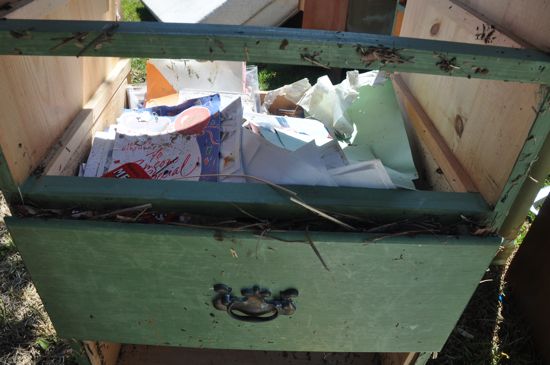 Evidence of water in places it shouldn’t be; dried Neuse river grasses in a drawer that held mementos.
Evidence of water in places it shouldn’t be; dried Neuse river grasses in a drawer that held mementos.And Liza says she is still finding Neuse river grasses tucked away in places where they couldn’t escape as the flood waters ebbed. They linger in the drawers of her daughter’s flooded dresser looking like a raffia project that went amok. It was as if Martha Stewart had been by, Liza says. Then she specifies, “… uninvited.”
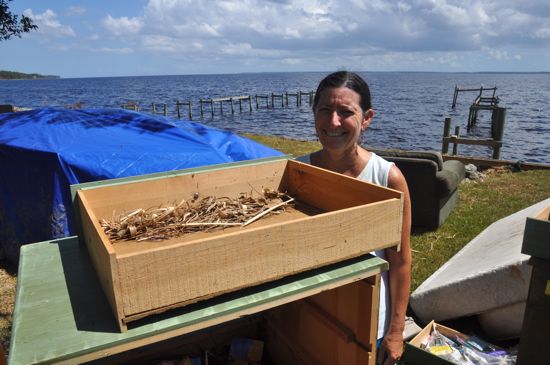 Raffia-ish. One of the dresser drawers that filled with Neuse river grasses.
Raffia-ish. One of the dresser drawers that filled with Neuse river grasses.Elsewhere, Irene’s effect was more brutal. It wasn’t just the wave action off of the Neuse that did damage. Dan and Liza had parked a truck and a van on higher ground behind the house. Water rose around it and then on top of that, literally, a tree fell and totalled both.
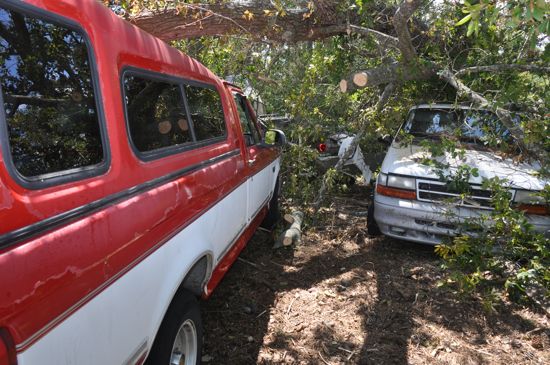 Wind damage too, as a tree came down on two vehicles that Dan Stafford parked on what he thought was high — and safe — ground.Closer to the house, a neighbor’s hot tub came to rest near their garden. Some of the plants there look like they’ll kick back to life.
Wind damage too, as a tree came down on two vehicles that Dan Stafford parked on what he thought was high — and safe — ground.Closer to the house, a neighbor’s hot tub came to rest near their garden. Some of the plants there look like they’ll kick back to life.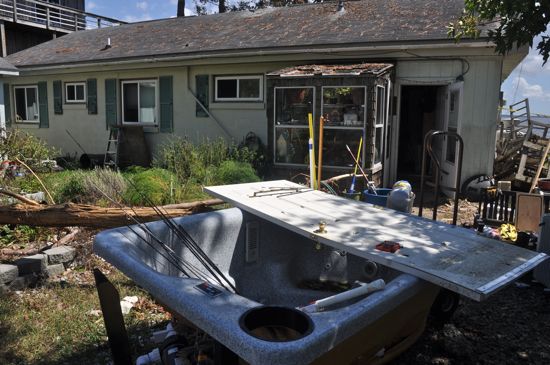 A neighbor’s hot tub floated up and down the road in Irene before the receding waters laid it in the yard.
A neighbor’s hot tub floated up and down the road in Irene before the receding waters laid it in the yard.As for the house itself, there are questions about what to do next. But no question about staying. “No way would we leave,” says Liza, “Unless the house leaves us.”
There is yet one more grace note in their home and it comes in the form of an older model refrigerator. That Kenmore has now been flooded in both Hurricanes Isabel and Irene. A week after Irene, Dan and Liza plugged it in and were amazed to find that it clicked on and began to keep things cold once again.
 Staying cool, staying power. Dan Stanford and Liza Wieland and the refrigerator that keeps on working.
Staying cool, staying power. Dan Stanford and Liza Wieland and the refrigerator that keeps on working.[page]
Jayne Stasser and her husband John Bloom bought their home on China Grove Road around the time of Isabel. With that in mind, and knowing what a hurricane can do, Jayne says that they spent three days prepping for Irene.
They moved tools and valuables off the floors of the garage and home. They secured their boat at its slip in Oriental. Her supply of biodegradeable bags and reusable bags which she sells at the Oriental Farmers Market, were put up high too. They even put their sofas up on blocks, just in case water came in the living room.
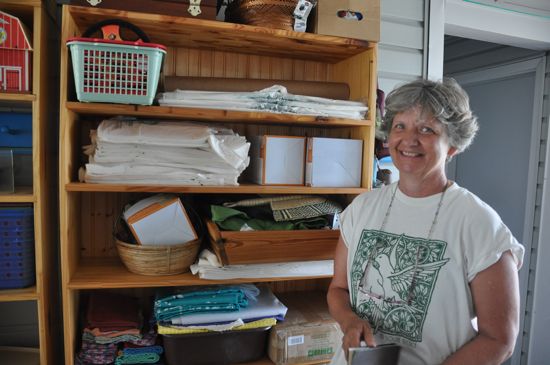 Jayne Stasser, who is often seen selling biodegradeable bags at the Oriental Farmers Market, near the stash that survived Hurricane Irene.
Jayne Stasser, who is often seen selling biodegradeable bags at the Oriental Farmers Market, near the stash that survived Hurricane Irene.The one thing they didn’t do, they say, was put hurricane shutters or plywood over the windows. Others in the neighborhood didn’t do that, citing the local wisdom — not uncommon — that it was the water, and not the wind that did the most damage in hurricanes here. By the time Friday August 26th came and the forecasts got more dire, they were thinking wood over windows might be a good idea, nonetheless. But by then, Jayne says, plywood was sold out locally.
Having done everything they could for their home, the retired university professors from Ohio took the official warnings seriously and drove to Raleigh to be out of the storm’s way. They didn’t need to witness it, they say. (Or as John self-mockingly puts it, “we have advanced degrees.”)
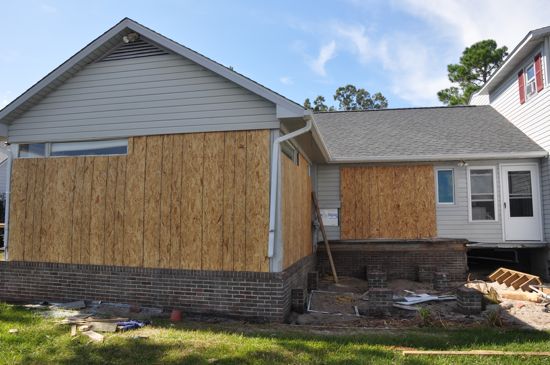 Jayne Stasser and John Bloom’s home on China Grove Road is boarded up now, after Hurricane Irene storm surge and debris smashed their windows. They say now they wished they’d put plywood over the windows before the surge sent debris and docks their way.
Jayne Stasser and John Bloom’s home on China Grove Road is boarded up now, after Hurricane Irene storm surge and debris smashed their windows. They say now they wished they’d put plywood over the windows before the surge sent debris and docks their way.They started to drive back Saturday afternoon as the area was still being belted with west winds from the back-end of Irene. The going was slow and got slower the closer they drove toward China Grove. “306 just kept getting worse,” Jayne says, and Janierio Road after Dawson’s Creek Bridge was covered in tree litter.
 One of a few outbuildings that lifted from yards and floated around the neighborhood along China Grove Road.
One of a few outbuildings that lifted from yards and floated around the neighborhood along China Grove Road.Arriving before dark, they drove down their street and saw that many neighbors got hit hard. At their own home, they found that hurricane shutters might have helped.
The best they can figure, a dock was churned up by the storm and propelled through the windows facing out on to the river. Water flooded their home. Their own back deck came loose in the high waters and went to a neighbor’s yard, likely the cause of his broken windows.
 A deck that they’d installed recently was torn up and out by Irene. .
A deck that they’d installed recently was torn up and out by Irene. .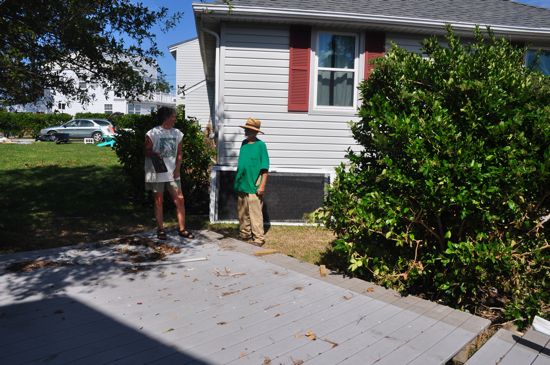 Jayne Stasser and John Bloom on deck. It came to rest on a side of the house. Made of recycled material, it may be recycled again.
Jayne Stasser and John Bloom on deck. It came to rest on a side of the house. Made of recycled material, it may be recycled again.As industrial strength fans blew hard to dry out the floors all over the house a week after the storm, Jayne was remarking at the randomness of it all. In the kitchen, the floor has a slope to it now. But in the living room, the sofas did stay up on their blocks, above the water and were good. A model boat on a mantelpiece didn’t move even thought water had likely swirled likely near the hearth. Ditto the framed photos that didn’t budge atop a dining room sideboard even as the bottom drawers got soaked.
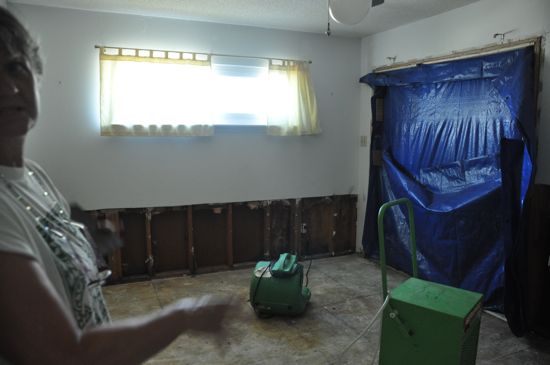 This room facing the river had had the best bed in the house, Jayne says, and they had piled it with other things that would otherwise have been on the floor, it preparation for the hurricane. The higher than expected waters thwarted those preparation efforts.
This room facing the river had had the best bed in the house, Jayne says, and they had piled it with other things that would otherwise have been on the floor, it preparation for the hurricane. The higher than expected waters thwarted those preparation efforts.Outside, a garden that had been thriving this summer — despite the river’s prevailing winds — didn’t survive the flood and churning debris. On the other side of the house, near the road, two Bradford pears were damaged and taken out. Jayne figures that she’ll plant the vegetable garden there next season; the silver lining is that the plants won’t have to contend with the river’s winds there.
 Tomatoes had been flourishing in this space, before Irene.
Tomatoes had been flourishing in this space, before Irene.A week after Irene, Jayne was taking the upheaval in stride. She and John have a furnished apartment over their garage — high and dry — and they are living out of there for now. For that, she says, she feels fortunate. So much so, that she says she’s told contractors to deal first with those who didn’t have a place to stay.
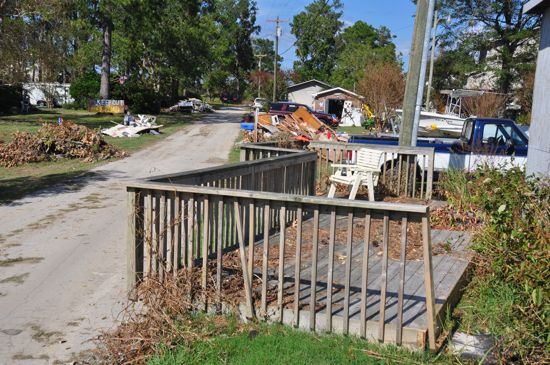 Along China Grove Road, the detritus of Irene, decks and docks loosened by the hurricane’s force came to rest in neighbors yards or ultimately, in debris piles at roadside.
Along China Grove Road, the detritus of Irene, decks and docks loosened by the hurricane’s force came to rest in neighbors yards or ultimately, in debris piles at roadside.For now, plywood blocks the view that her windows used to give of the Neuse. Despite that, Jayne takes in an even bigger picture.
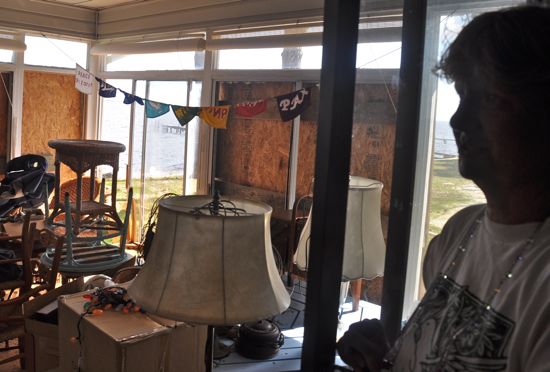 The sunroom, festooned with peace flags, is now covered in plywood. Some light gets in through one window, giving a glimpse of the river.
The sunroom, festooned with peace flags, is now covered in plywood. Some light gets in through one window, giving a glimpse of the river.Standing on her lawn, where glass and grass still mix, she gestures to the river and lays it out in a plainspoken way. There are miles of open river, Jayne says, and if there’s a hurricane, she knows her house is going to feel it. It comes with the territory, and it’s territory she and her husband plan to stay in.
Five nights after the hurricane, she says, the two of them sat out near the dock that now needs fixing, and looked at the river, calm once again. They agreed, she says, that this is why they came here and this is why they’ll stay.
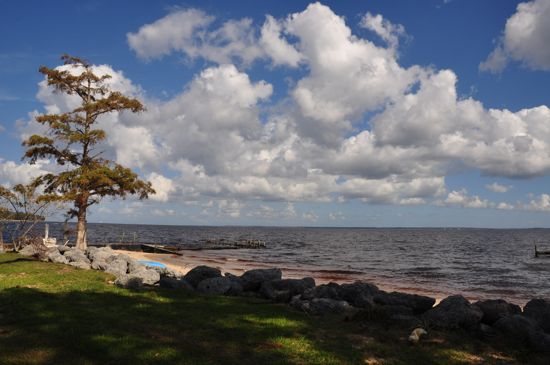 View of the Neuse from China Grove yard of Jayne Stasser and John Bloom.
View of the Neuse from China Grove yard of Jayne Stasser and John Bloom.
